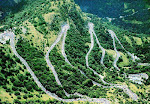Given the role they play, what I'm finding difficult to understand is why bike manufacturers are increasingly viewing this component as somehow optional in their advertising. Surely their omission renders the bike incomplete, unrideable, useless, in the same vein as advertising a Ferrari without its Pirelli P Zeroes might be. Look through bike mags and sites and you'll note the trend to include bike weights quoted excluding pedals, as if this unsung component were somehow simply an optional extra. Marvel over expensively lit studio shots of the top-of-the-range machine in question, nothing left to chance in the attempt to engender unbridled desire for their product, and the very means of propulsion are missing. If it were a refreshing bottle of lager, it would've had the complete food-stylist treatment and be sprayed with droplets of condensation, to reach out and whisper 'chilled' and 'thirst quenching'. On bikes the ten-past-two wristwatch-marketing equivalent has always been displaying the bike in the big ring and smallest sprocket, since 53x12 shouts speed (but only when you're using our bike, obviously). But including pedals, surely.
I've already mentioned the wonderful advertising that Ten Speed Drive Imports used to place in Winning Magazine in the 1980s in this blog - it was teenage desire-affirming hard-core bike porn, not seen anything like it since, more's the pity - and the pedals were always on there. Why wouldn't they be?
 |
| Image by steel-is-real |
Perhaps back in the day it was a given that if you'd selected a Campag
gruppo for your bike, then the pedals would also be from Vicenza - and no doubt matched with their alloy toe-clips and Alfredo Binda Extra toestraps. The same would be true of a Shimano or Stronglight/Spidel equipped bike: all the advertisements would include a pedal, out of - dare I venture - completeness. So, was it simply because in the past there was less choice, and so less scope for upsetting a potential punter's sensibilities with the inclusion of what might not be their preferred pedal? Best not try and influence their thinking, heh?
Today, the bars, the saddle, the groupset, wheels and tyres are all still there - unsurprisingly to me - but frame manufacturers appear to baulk at going as far as including pedals. The only reason I can think for their exclusion is that the multitude of providers, styles and engagement mechanisms preclude them from being displayed, as if the frame manufacturer is avoiding the endorsement of a particular brand or mechanism through fear of causing some kind of offence - we're all so easily offended these days after all - leaving this gaping hole in the complete picture to be filled by the consumer's personal whim. Show them a pedal option they don't like, and they might pass on the bike as a whole. Then again, surely any component selection is only about personal taste, and we can mix and match as much as we like (although it's not something I'd do - I'm unashamedly Italian when it comes to what I choose for my bikes)?
So what is it with pedals? Check out these top-flight 'hero' bikes on these manufacturers' sites, and you'll note that there's not a pedal to be seen:
I don't get it. I've already touched on contact points (yep, pun intended), but surely tyre choice is just as personal, with a potentially broader gamut available depending on intended usage. The modern trend for factory-built wheelsets would also undermine this reasoning - high-profile or low, ceramic bearings or not, tubulars or clinchers. Or even the latest road-tubeless innovations. So, does anyone out there have any ideas? What is it about poor old pedals that makes them persona non-grata in bike advertsing?
So what is it with pedals? Check out these top-flight 'hero' bikes on these manufacturers' sites, and you'll note that there's not a pedal to be seen:

No comments:
Post a Comment
Thanks for taking the time to comment - it's appreciated.